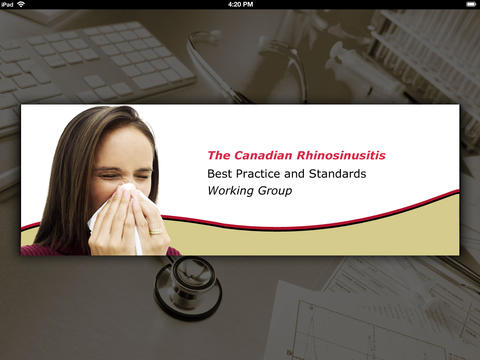
Sinusitis Toolbox app for iPhone and iPad
Developer: Astron Infotech LLC
First release : 09 Jul 2012
App size: 73.33 Mb
This interactive reference application allows physicians to evaluate their patient’s sinusitis conditions by utilizing the various mnumonics, algorithms, videos and clinical pictures. There is even a quiz included to test your knowledge of the guidelines.
The goal of this application is to present information in an understandable, readable fashion that targets key points pertinent to individuals offering first-line care for patients with acute [ABRS] or chronic [CRS] rhinosinusitis. Using the application is easy - simply walk through the algorithms by touching or sliding the screen. At each clinical decision point you will be asked a question regarding duration, symptoms or clinical tests, once you touch to respond, you will be brought to another screen that will provide recommendations or another clinical decision as necessary.
As a primer, this application includes a step-by-step nasal examination training sessions where Dr Tewfik walks the viewer through the examination with key points and clinical tips.
The videos enable the physician to clearly see images from an endoscope or a CT scan of actual real-life patient conditions. Included is an outline of what the condition is as well as some helpful tips. This library of images includes:
•Base-line normal
•ABRS
•Antrochoanal polyp
•Nasal valve collapse or stenosis
•Chonic rhinosinusitis and nasal polyposis – sever
•Deviated Septum
•Turbinate enlargement – hypertrophy
•Septal perforation
•Uncomplicated mild-moderate CRS
•Allergic rhinitis
•Complicatons of acute sinusitis
•Nasal polyosis
•Chronic rhinosinusitis
•Chroinic rhinosinusitis with allergic fungal sinusitis
The application was developed based on Canadian guidelines that were developed for all adult Canadians over 18 years of age and do not apply to the pediatric population. The guidelines and applicationare intended to provide guidance on the following clinical questions about acute and chronic sinusitis in adults:
•Is it a cold, allergy, or sinusitis?
•How is a patient with acute or chronic sinusitis identified?
•What is the appropriate investigation of the patient with suspected acute or chronic sinusitis?
•Are antibiotics required for the management of all cases of acute bacterial sinusitis?
•When should a patient with suspected acute or chronic rhinosinusitis be referred?
•How are complications detected in a patient with sinusitis?
•What is the optimal management of sinusitis?
•What are the evidence-based recommendations for appropriate selection of nonmedical and medical therapies for the management of acute and chronic sinusitis?
•How are patients with chronic sinusitis managed over the long term?



